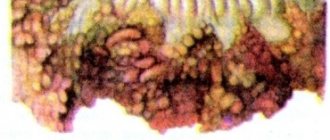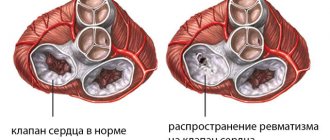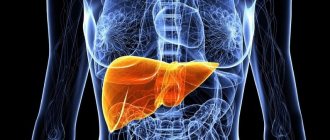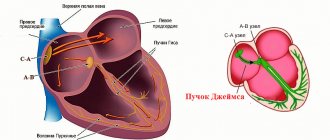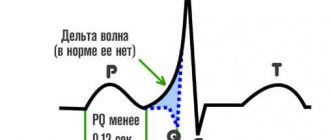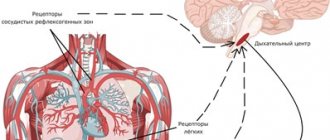Postthrombophlebitic syndrome is a chronic, intractable pathology localized primarily in the blood vessels of the legs. The symptom complex is diagnosed in 5-8% of patients; the main reason for its occurrence is the patient’s history of DVT (deep vein thrombosis). In medical practice, a number of synonyms and abbreviations are used to denote the disease, including postphlebitic disease, PTF, PTB, postthrombotic venous insufficiency, PTF of the lower extremities.
Postthrombophlebitic syndrome - what is it?
Postthrombophlebitic syndrome (PTPS) is a complex of pathological symptoms that develop after deep vein thrombosis, subject to insufficient recanalization of thrombosed venous segments and weak compensatory capabilities of the body. In modern European literature, postthrombophlebitis syndrome is also called venous stress disorder. A disease that occurs as a complication of long-term disruption of venous outflow after deep vein thrombosis (DVT). Postthrombophlebitic disease
Prognosis and complications
Absolute relief of the syndrome cannot be achieved, but following the recommendations of the attending physician helps achieve remission.
If therapy is refused, a number of complications develop. Among them:
- addition of infection;
- venous gangrene;
- impaired lymphatic drainage;
- lymphedema;
- erysipelas of the legs.
If a blood clot breaks off, the disease is fatal.
Causes of postthrombophlebitis syndrome
Even with ongoing research, the causes of PTFS remain incompletely understood. According to modern European data, the following chain of events leads to the development of postthrombophlebitis syndrome. The inflammatory reaction that occurs in response to the presence of thrombotic masses in the lumen of blood vessels causes injury and subsequent tissue fibrosis. Venous valves are damaged and deformed, mostly mechanically from a blood clot. The resulting valvular incompetence, combined with persistent venous obstruction, increases the pressure in the veins and capillaries. Venous hypertension causes congestion in tissues, such as rupture of small superficial veins, subcutaneous hemorrhage, and increased tissue permeability. This in turn is manifested by symptoms such as pain, swelling, hyperpigmentation, lipodermatosclerosis and even ulcers.
Pathogenesis
The trigger mechanism that activates PTPS is the formation of blood clots. The further development scheme of PTF legs is conventionally divided into 3 stages. Among them:
- Formation of connective tissue on vascular walls due to lysis of a blood clot and progression of the inflammatory process. Blockage of an elastic tubular formation is called occlusion.
- Partial recanalization of the thrombus. Deformation of the affected area, insufficiency (loss) of the valve apparatus.
- The occurrence of fibrosis. The growths compress the vein, increase pressure and disrupt the outflow of blood, lead to reflux of the biological environment from deep vessels to superficial ones, and provoke the formation of recurrent thrombosis.
According to statistics, up to 90% of the listed irreversible changes lead to the development of PTB of the legs after 3-5 years from the moment of appearance. In 10% of patients, manifestations of the syndrome are diagnosed faster - after 12 months.
Postthrombophlebitic syndrome is a severe chronic pathology
Postthrombophlebitic syndrome occurs a certain time after suffering venous thrombosis. Symptoms of the disease may occur six months or more after the thrombotic event. The course of the disease is always severe. Signs of chronic venous insufficiency progressively increase, trophic disorders appear and increase.
Postthrombophlebitis syndrome significantly reduces a person’s quality of life after deep vein thrombosis, especially in relation to physical activity, causes changes in the patient’s psycho-emotional sphere and leads to restrictions in daily activities.
Preventing relapse of the disease
After successful treatment of thrombosis and postphlebitic syndrome, patients are shown a complex of anticoagulant therapy using direct or indirect anticoagulants. Thus, the use of: heparin, fraxiparin, fondaparinux, warfarin, etc. is relevant.
The duration of this therapy can only be determined on an individual basis, taking into account the reasons that led to the development of the disease and the presence of a persistent risk factor. If the disease was provoked by injury, surgery, acute illness, or prolonged immobilization, then the duration of therapy usually ranges from three to six months.
Compression therapy, especially using easy-to-use knitwear, is one of the most important points in compensating for all types of CVI.
If we are talking about idiopathic thrombosis, then the duration of use of anticoagulants should be at least six to eight months, depending on the individual characteristics of the patient and the risk of relapse. In the case of recurrent thrombosis and a number of remaining risk factors, the course of taking drugs can be quite long, and sometimes lifelong.
Postthrombophlebitic syndrome - symptoms
Signs and symptoms of postthrombophlebitis lower extremity syndrome may include:
- pain
- night muscle cramps
- heaviness
- itching and/or tingling
- edema
- phlebeurysm
- skin hyperpigmentation
- lipodermatosclerosis
- trophic ulcer.
These signs and symptoms can vary significantly between patients and over time, the clinical picture changes in the direction of increasing severity. In postthrombophlebitis syndrome, symptoms usually worsen after prolonged walking or standing and improve with rest or a horizontal position of the lower limb.
Forecast
In the absence of proper treatment, the prognosis of the disease is extremely unfavorable. Patients are at significant risk of developing tissue necrosis and gangrene. The formation of blood clots in this case also occurs frequently. This in turn can lead to a stroke or heart attack. When a blood clot breaks off, it may penetrate into the inferior vena cava, and then into the pulmonary trunk. This can trigger the development of pulmonary embolism, a fatal condition. Trophic ulcers are another common complication of PTFS. Their danger lies in the fact that they are open wounds into which infection can penetrate at any time.
Postthrombophlebitic syndrome, stages and forms
Postthrombophlebitis syndrome is part of the structure of diseases manifested by symptoms of chronic venous insufficiency (CVI). The most modern and relevant gradation of postthrombophlebitis syndrome today is the CEAP classification. This tool most accurately describes the trophic and morphological changes that occur in the lower limb during the development of pathology. Also, doctors in many public medical institutions use the GHPratt classification, as modified by M.I. Cousin. According to it, postthrombophlebitis syndrome is divided into the following forms:
- Edema and pain
- Varicose
- Ulcerative
- Mixed
Classification
Based on the manifestations of specific signs and characteristics of the course, a classification of postthrombophlebitic disease has been developed, highlighting certain forms:
- varicose;
- edematous with severe pain;
- ulcerative;
- mixed (including several basic symptoms).
The course of the disease is divided into stages of development of pathological changes:
- the initial stage is characterized by occlusion (stable blocking of the lumen) of the venous vessels formed by a blood clot, swelling, pain, dilatation of the veins;
- the second stage corresponds to the processes of gradual recanalization (restoration of the patency of a vessel blocked by a thrombus and the movement of blood through it) and a high probability of subsiding of the severity of skin manifestations;
- at the third stage (unfavorable course), obliteration (overgrowth with connective tissue) of the vessel with complete blocking of blood flow is possible, as well as the development of trophic changes, increased swelling, and pain.
Based on the area of damage to the veins of the lower extremities, the following syndrome is distinguished:
- with impaired blood flow to the vessel in the femoral-popliteal area;
- with closure of the vein in the iliofemoral region.
Postthrombophlebitic syndrome, diagnosis
Diagnosis of postthrombophlebitis syndrome is based on a clinical examination of the patient, assessment of complaints and anamnesis. Also an important diagnostic criterion is modern ultrasound duplex scanning.
The signs and symptoms of acute deep vein thrombosis and postthrombophlebitis syndrome are quite similar. Therefore, the diagnosis of postthrombophlebitic syndrome is relevant and legitimate only 3–6 months after an episode of acute venous thrombosis. This is due to both the possibility of recanalization of thrombosed veins and the good compensatory capabilities of the body. For an even more accurate assessment of organic damage to the venous system and planning corrective interventions, the following are used:
- Multispiral computed angiography with contrast enhancement.
- Magnetic resonance venography.
- Intravenous ultrasound diagnostics (IVUS).
- X-ray contrast venography.
Clinic and classification of PTFS of the veins of the lower extremities
Postphlebitic illness has certain signs - they appear at the beginning of the pathological process. The clinic is discussed in cases where the disease is actively progressing.
Signs include swelling of the legs that does not go away over a long period of time. Spider veins and spider veins appear on the legs. Patients complain of cramps at night, fatigue in the legs, heaviness, and decreased sensitivity of the limbs.
A symptom such as “wobbly legs” appears. After being in a standing position for a long time, the patient simply does not feel his limbs and has difficulty moving his legs. This symptom tends to intensify in the evening.
The table shows the clinical picture of the disease depending on the degree of damage to the veins of the lower extremities:
| Stage of PTFS of the deep veins of the legs | Clinical manifestations |
| Easy stage |
|
| Middle stage |
|
| Severe stage |
|
Latest information: Ointments for trophic ulcers of the lower extremities with varicose veins
During the compensation period, the patient may have all the described clinics. When trophic ulcers appear, this indicates decompensation of the pathology. They are often complicated by infection. The symptoms of the disease do not depend on gender, and the severity of the manifestation is determined by the severity of the disease.
Why is postthrombophlebitis syndrome dangerous?
Postthrombophlebitic syndrome is a severe pathology, often leading patients to disability. Essentially, this is a complication of deep vein thrombosis. Symptoms of the disease often progress, making life increasingly difficult for patients. Often, relapses of deep vein thrombosis occur against the background of PTFS. In some cases, an even more dangerous pathology, pulmonary embolism, may develop. Postthrombophlebitis syndrome, even today, with a wide arsenal of conservative and invasive methods, cannot be completely cured. Therefore, it is so important to promptly and competently treat the pathology of the venous system, remove varicose veins, and carry out adequate treatment of deep vein thrombosis.
Symptoms
Patients experience swelling in the lower leg area. It is worth noting that usually the left leg swells more than the right. The swelling may gradually spread to the ankle or thigh area. Patients often notice that their shoes become too small for them and they begin to put pressure on their feet (especially in the evening). If you press your finger on the skin in the area of swelling, a dent will remain in this place, which does not straighten out for a long time. The elastic from a sock or golf also leaves visible marks on the skin that do not disappear for a long time.
Usually in the morning the swelling subsides a little, but does not disappear completely. A person constantly feels heaviness, stiffness and fatigue in his legs. If you strain the muscles of your limbs, you will feel a dull, bursting pain. The unpleasant syndrome intensifies if you remain in the same position. When you raise your legs above your head, the discomfort gradually subsides.
Postthrombotic disease is the cause of re-development of varicose veins in approximately 65-75% of cases. Most often, expansion of the deep veins of the lower extremities occurs in the area of the feet and legs. According to statistics, 8-12% of people with PTFS develop trophic ulcers. They most often appear on the inside of the ankles or shins. Significant trophic skin changes can be considered a precursor to their development:
- The epidermis acquires a dark shade, and many pigment spots appear.
- Seals appear.
- Signs of inflammation appear both on the surface of the skin and in its lower layers.
- At the site where the ulcer develops, an area of skin covered with a whitish coating appears.
Trophic ulcers are difficult to treat; they are often subject to secondary infection.
Postthrombophlebitic syndrome - treatment in Moscow
Treatment of postthrombotic syndrome in Moscow is carried out by vascular surgeons and phlebologists, both in public and private city medical centers. Treatment includes conservative measures and surgical interventions.
The first include:
- Wearing compression stockings.
- Application of variable pneumatic compression and electrical myostimulation.
- Drug therapy (drugs to improve microcirculation, angioprotectors, phlebotonics).
The main types of modern surgical interventions for postthrombophlebitic syndrome:
- Interventions aimed at correcting pathological discharge of blood from deep veins to superficial ones (laser or endoscopic removal of perforating veins).
- Operations to reduce the pathological venous volume (for varicose form of PTF) - laser and radiofrequency thermal obliteration, miniphlebectomy.
- Interventions aimed at improving the outflow of blood through the affected veins are shunt interventions. The most commonly performed is ileofemoral bypass under X-ray control.
Why does the disease occur?
PTFS is a secondary disease. This means that it is a consequence and continuation of another pathology - acute phlebothrombosis. Only this disease can act as an etiological factor - the only cause of postthrombophlebitis syndrome.
In order for pathological changes to occur in the deep veins, blood clots must first form in them. This process always happens very quickly and suddenly (within a few hours). This disease is called acute phlebothrombosis or deep vein thrombophlebitis. It is characterized by the same changes in the venous wall as with PTFS - inflammation and blood clots, but they are just beginning and can be reversible.
The formation of blood clots in the deep veins is the cause of PTFS
It is believed that acute phlebothrombosis (deep vein thrombophlebitis) lasts 4 weeks. After this time, the pathological process is already regarded as postthrombophlebitic disease or syndrome.
What happens to the veins - mechanisms of disease development
Blood flows through the deep veins of the lower extremities from the foot to the thigh, and then to the heart. If an obstacle occurs in any part of this system, the vessels underlying it experience increased pressure. Over time, they are unable to hold and transport blood, which causes it to spread to the saphenous veins. As a result, they wriggle and expand in the form of varicose veins.
If the pressure continues to be maintained, the stagnant blood sweats through the venous wall, causing inflammation in the tissues - skin, muscles, tendons. Over time, they lose their normal structure, necrosis (death) occurs with the formation of large and deep non-healing wounds in these places - trophic ulcers.
The course of PTF depends on several factors:
- The diameter and location of the affected vein - the larger it is, the larger part of the limb venous insufficiency (blood stasis) will spread.
- The volume and extent of areas of inflammation with blood clots - the larger they are, the slower they dissolve, the worse the lumen is restored, and the stronger the cicatricial narrowing of the vein.
- Involvement of venous valves. This threatens with irreversible circulatory impairment and severe venous insufficiency.
- Involvement of perforating veins, through which blood is discharged into the subcutaneous system in order to create bypasses and facilitate outflow.
- The presence of low-grade inflammation in the vein. In this case, blood clots continue to form, spreading to healthy areas of the venous wall in both directions from the primary site of the lesion (up and down). Under such circumstances, the lumen of the vein will never be restored.
Interesting to know! About 10% of patients with PTFS claim that they have never suffered acute phlebothrombosis. This is possible with a latent course of this disease with moderate swelling of the affected leg.
Development of the disease - photo gallery
Formation of a blood clot in the femoral vein, blocking its lumen
Due to stagnation of blood, the pressure in the veins below the narrowing site is increased
Blood clots dissolve over time, but inflammation destroys venous valves
From deep veins, blood is discharged into superficial veins through perforators, which causes varicose veins
Postthrombophlebitic syndrome - prevention
Prevention of postthrombophlebitis syndrome begins with the prevention of primary and recurrent deep vein thrombosis. For people hospitalized at high risk of DVT, prevention strategies should include early mobilization, use of compression stockings or variable compression devices, electrical stimulation, and/or anticoagulant medications.
For already diagnosed thrombosis, the innovative thrombolysis technique shows good results. This is an endovascular procedure aimed at dissolving a thrombotic clot in a vein. Also, to prevent postthrombophlebitis syndrome, adequate anticoagulant therapy is necessary.
European vascular surgeons and phlebologists recommend weight loss for overweight patients who have already suffered deep vein thrombosis.
Prevention: what you can do
There are no specific measures that could reliably prevent postthrombophlebitis syndrome. The main thing is to prevent the occurrence of acute deep thrombophlebitis, since only after it does this disease develop. For this purpose it is necessary:
- monitor blood clotting;
- avoid leg injuries;
- avoid prolonged stay in a position with legs down;
- do unloading exercises for the legs;
- normalize weight;
- to refuse from bad habits.
But if the problem has already arisen, you should contact a phlebologist, vascular surgeon or general surgeon for specialized help as soon as possible. This can prevent serious consequences.
Frequently asked questions from our patients on the Internet about postthrombophlebitic syndrome
What to do to avoid postthrombophlebitis syndrome? Natalya from Minsk is interested in:
Dear Natalia! To avoid post-thrombophlebitis syndrome, it is necessary to periodically undergo examination by a phlebologist with a modern ultrasound scan of the venous system of the lower extremities. If venous thrombosis has already occurred, you need to follow the recommendations of your doctor, use compression stockings, and take prescribed medications.
What is the best way to treat postthrombophlebitis syndrome in Moscow? Yulia asks from Moscow:
Dear Yulia! If you have been diagnosed with postthrombophlebitis syndrome, you need to consult a good phlebologist or vascular surgeon in Moscow, with the obligatory performance of modern ultrasound duplex scanning and strictly follow the doctor’s recommendations.
What is postthrombophlebitis syndrome of the lower extremities? Nikolay from Moscow is interested:
Dear Nikolay! Postthrombophlebitic syndrome of the lower extremities is a very serious complication of deep vein thrombosis, manifested by swelling, pain, skin hyperpigmentation and trophic ulcer. Even the most modern European technologies today do not guarantee a complete cure for postthrombophlebitis syndrome of the lower extremities.
What is the modern treatment for postthrombophlebitis syndrome of the lower extremities in Moscow? Maria from Moscow asks:
Dear Maria! Modern treatment of postthrombophlebitis syndrome in Moscow is performed in city phlebological and vascular centers. Treatment will depend on the clinical form of the disease: edematous-painful, varicose, ulcerative and mixed. Also, the choice of modern treatment for postthrombophlebitis syndrome is based on the degree of venous occlusion (obstruction). If indicated, modern minimally invasive stenting operations are performed under X-ray control.
Treatment
Postthrombophlenic syndrome and the accompanying chronic venous insufficiency cannot be completely cured. The main goals of treatment are aimed at slowing the progression of the disease as much as possible. For this the following can be used:
- compression therapy: wearing compression garments and bandaging the limb with elastic bandages to eliminate venous hypertension;
- lifestyle correction: sufficient physical activity, giving up bad habits and correcting the diet;
- drug therapy: taking medications that can improve the condition of the venous walls, help eliminate the inflammatory process and prevent the formation of blood clots;
- preparations for local treatment: the use of ointments, creams and gels that promote the healing of trophic ulcers and normalize blood circulation;
- physiotherapy: helps normalize blood circulation in the limbs and improves metabolic processes in the skin;
- surgical treatment: aimed at preventing embolization of blood clots and the spread of the pathological process to other venous vessels; as a rule, radical surgical techniques are used for PTS.
Conservative treatment is used when the disease dynamics are favorable and there are contraindications to surgery.
Compression therapy
Patients with chronic venous insufficiency and trophic ulcers are recommended to use elastic bandages or wear compression socks, tights or tights throughout treatment. The effectiveness of compression therapy has been confirmed by many years of clinical trials: in 90% of patients, its long-term use allows for improvement in the condition of the veins of the limb, and in 90-93% of patients with trophic ulcers, faster healing of damaged skin areas is observed.
As a rule, in the first stages of the disease, the patient is recommended to use elastic bandages for bandaging, which allow maintaining the level of compression required in each given clinical case. As the patient's condition stabilizes, the doctor recommends that he wear compression stockings (usually knee socks).
If there are indications for the use of class III compression hosiery, the patient may be recommended to use a special set, Saphenmed ucv., which consists of two knee socks that create a total resting pressure of 40 mm at the ankle level. The structure of the material of the inner stocking includes plant components that promote faster regenerative processes and have a tonic effect on the veins. Their use is also convenient because the products are easy to put on, and one of the socks can be removed during night sleep to reduce discomfort.
Sometimes wearing elastic bandages or compression knitwear causes significant discomfort to the patient. In such cases, the doctor may recommend that the patient apply a bandage made of special zinc-containing non-stretchable bandages from the German manufacturer Varolast. They are able to create low compression at rest and high compression during physical activity. This completely eliminates the discomfort that can occur with conventional compression devices and ensures that persistent venous edema is eliminated. Varolast bandages are also successfully used to treat open and long-term non-healing trophic ulcers. They contain zinc paste, which has a stimulating effect on tissues and accelerates the process of their regeneration.
In severe cases of postthrombophlebitis syndrome, progressive venous lymphedema and long-healing trophic ulcers, compression therapy can be performed using the pneumatic intermittent compression technique, which is carried out using a special apparatus consisting of mercury and air chambers. This device creates intense sequential compression on various parts of the lower limb.
Lifestyle correction
All patients with postthrombophlebitis syndrome are recommended to adhere to the following rules:
- Regular follow-up with a phlebologist or vascular surgeon.
- Limiting physical activity and rational employment (work that involves standing for long periods of time, heavy physical labor, work in conditions of low and high temperatures is not recommended).
- Rejection of bad habits.
- Exercise therapy classes with dosing of physical activity depending on the doctor’s recommendations.
- Following a diet that involves excluding from the diet foods and dishes that contribute to blood thickening and cause vascular damage.
Drug therapy
To treat chronic venous insufficiency, which accompanies postthrombophlebitic syndrome, medications are used that help normalize rheological parameters and blood microcirculation, protect the vascular wall from damaging factors, stabilize lymphatic drainage function and prevent the release of activated leukocytes into the surrounding soft tissue. Drug therapy should be carried out in courses, the duration of which is about 2-2.5 months.
Russian phlebologists recommend a treatment regimen consisting of three successive stages. At stage I, which lasts about 7-10 days, drugs for parenteral administration are used:
- disaggregants: Reopoliglyukin, Trental, Pentoxifylline;
- antioxidants: vitamin B6, Emoxipin, Tocopherol, Mildronate;
- non-steroidal anti-inflammatory drugs: Ketoprofen, Reopirin, Dicloberl.
In the case of the formation of trophic purulent ulcers, the patient is prescribed antibacterial drugs after carrying out cultures on the flora.
At stage II of therapy, along with antioxidants and antiplatelet agents, the patient is prescribed:
- references: Solcoseryl, Actovegin;
- polyvalent phlebotonics: Detralex, Vasoket, Phlebodia, Ginkor-fort, Antistax.
The duration of this stage of treatment is determined by individual clinical manifestations and ranges from 2 to 4 weeks.
At stage III of drug therapy, the patient is recommended to take polyvalent phlebotonics and various drugs for topical use. The duration of their use is at least 1.5 months.
The treatment regimen may also include mild fibrinolytics (Nicotinic acid and its derivatives), diuretics and agents that reduce platelet aggregation (Aspirin, Dipyridamole). In case of trophic disorders, antihistamines, AEvit and Pyridoxine are recommended, and if there are signs of dermatitis and allergic reactions, consultation with a dermatologist to prescribe further treatment.
Preparations for local treatment
Along with drugs for internal use, in the treatment of postthrombophlebitic syndrome, agents for local action in the form of ointments, creams and gels that have anti-inflammatory, phleboprotective or antithrombotic effects are actively used:
- Heparin ointment;
- ointment forms of Troxerutin and Rutoside;
- Lyoton;
- Venobene;
- Indovazin;
- Venitan;
- Troxevasin;
- Venoruton;
- Cyclo 3 cream, etc.
Drugs with different effects should be used at certain intervals throughout the day. The product must be applied to previously cleansed skin with light massage movements several times a day.
Physiotherapy
At different stages of treatment of postthrombophlebitis syndrome, various physiotherapeutic procedures can be used:
- for vein toning: intraorgan electrophoresis using venotonics;
- to reduce lymphostasis: segmental vacuum therapy, electrophoresis with proteolytic enzymes, lymphatic drainage massage, LF magnetic therapy;
- for defibrotization: electrophoresis with defibrosating drugs, iodine-bromine and radon therapeutic baths, ultrasound therapy, peloid therapy;
- for correction of the autonomic nervous system: SUV irradiation, diadynamic therapy, HF magnetic therapy;
- to accelerate tissue regeneration: LF magnetic therapy, local darsonvalization;
- for a hypocoagulating effect: electrophoresis with anticoagulating drugs, laser therapy with infrared irradiation, hydrogen sulfide and sodium chloride baths;
- to stimulate the muscular layer of the venous walls and improve hemodynamics: pulsed magnetotherapy, amplipulse therapy, diadynamic therapy;
- to eliminate tissue hypoxia: oxygen barotherapy, ozone baths.




